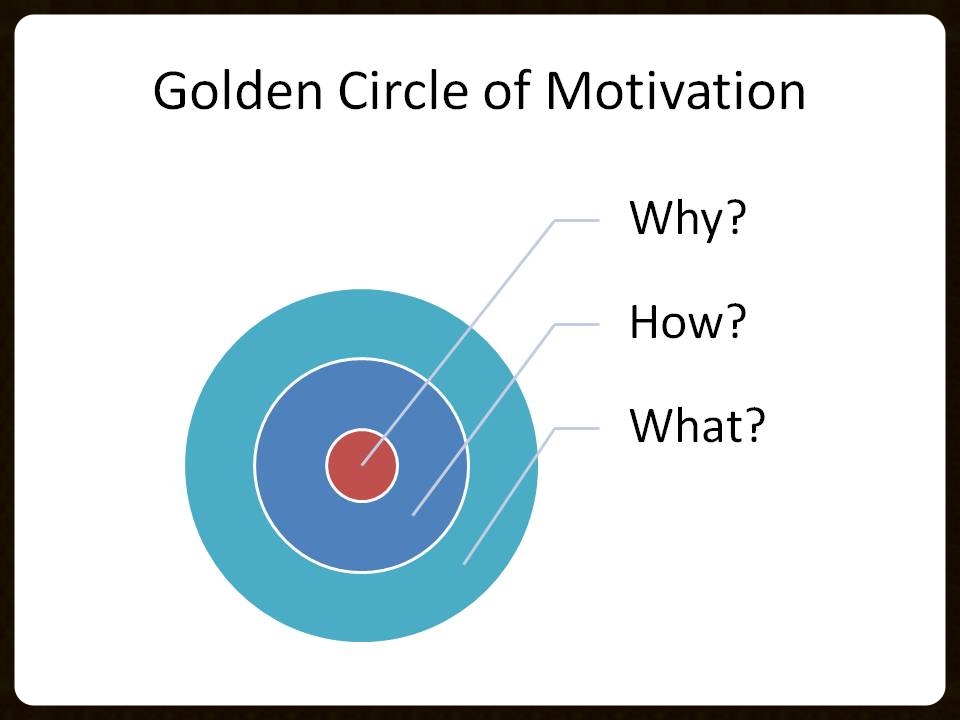The Golden Circle of Motivation centers on Why.
The funeral business is changing and that is evident in several trends: decreasing death rate, increasing life expectancy, increasing cremation rate, rising employer costs, rising cost of health care, decreasing asset to debt ratios, and man more. Every one of these topics is the subject of news articles and op-ed pieces in every publication on-line and off-line from which we opt to fill our minds. There's no shortage of opinions on the profitability (or lack thereof) in death care service or where the industry is headed next. One thing for sure is that for those fifth and sixth generation funeral directors, operating a funeral service business today is nothing like it was five generations ago when cash and bartering were the primary means of transacting business.
In a previous installment of this column I wrote about the Golden Circle of Motivation as presented by Simon Sinek in a TED talk. In about ten minutes Mr. Sinek makes a compelling argument for any commercial business to re-invent our marketing message to focus on why we do what we do. Answers like "to make money" are not valid. A business makes money to exist, it does not exist to make money. Mr. Sinek uses breathing as an analogy. We breath to live, not the other way around. Typically most employees in a business can explain what they do. Very few can explain how they do it. And even fewer know why. For some firms, nobody can articulate why their firm exists. But those who can explain why, and can explain effectively, already have their go-to-market message.
In these contemporary times of volatile markets, political challenges, and ever-rising cost of doing business, it is hard enough to keep a business in The Black. Add to our challenges this new breed of consumerism with the loyalty of Benedict Arnold and the attention span of Sponge Bob exposed to more information in a day today than a person was exposed to in an entire month in 1881 when President James Garfield was shot by Charles Guiteau.
How might the funeral industry today adapt? Can we leverage our values in sustainability in our go-to-market messaging to earn more loyalty with a contemporary consumer? Could Green & Gold lead us to The Black?
My first coffin was for Grandpa.
Ten years ago I designed and built my first casket with my family for my Grandfather. Nine years ago we sold our first "green” casket kit online. About six years ago we discovered, almost by accident, that people were more interested in why I decided to build caskets than how we build them. Like many businesses, we have a web site that describes what we are selling. For a short period I thought it clever to describe in great detail how we build caskets. Then about four years ago I listened to Simon Sinek's TED talk and things haven't been the same since we focused our messaging on why. We are using our casket business to plant trees—lots and lots of trees. Ten million, to be exact. This is an easy message for our followers to support and repeat. Sales have more than doubled in each of the three years since we have re-focused our go-to-market messaging on why we build environmentally friendly, non-toxic, and sustainable caskets.
I share this with you and anyone interested enough to re-think their marketing message. For those of you who are 5th or 6th generation funeral directors, I applaud you. For those of you just entering this industry, I applaud you. You are both likely very close to explaining "why" you have remained in, or have recently chosen, this profession. As for the rest of us… can we quickly and effectively explain "why does my firm exist" or "why am I a funeral director" to a 10 year-old? Keep in mind that "make money" is a not a valid answer. Not everyone's answer is the same--and need not be. Your answer is your own--it is your Golden Circle of Motivation. Making your motivation transparent for your customers will have a profound impact on both their attention span and their loyalty.
So maybe you get the Gold, but where's the Green in the Black? I illustrate with my own experience. I don't build caskets to make money--there are a lot of other ways I could make money, and some are far easier than making caskets. And I don't just make caskets. I make sustainable, eco-friendly, non-toxic, locally sourced, carbon-negative caskets because I am fascinated by the challenge of building a business on Smarter Planet ideas. I plant lots and lots of trees because I believe that nobody can argue that planting trees isn't a great thing. I source raw materials and manufacture with local talent so that I can create jobs in my community. This is my passion. Before listening to Mr. Sinek, I was shy about my passion and kept my motivations private. I now realize that not only was there no need to hide my motivation. Making my personal motivation transparent has only helped to build trust in personal relationships, longer attention spans, and true loyalty from our clients and followers.
I invite you to find the why in your motivation. Yes, I admit Green is arguably an already over-played marketing moniker and trend. It is no longer relevant to a consumer to tout our wares as simply Green--that's not good enough. Go for the Gold and tell your customers why you do what you do. Add a little Green to that Gold and you will find yourself on the path to Black.




